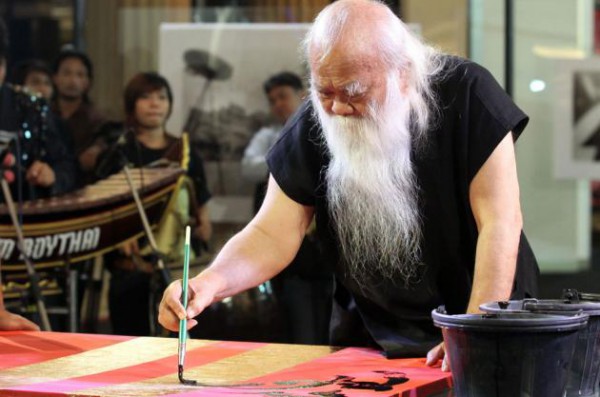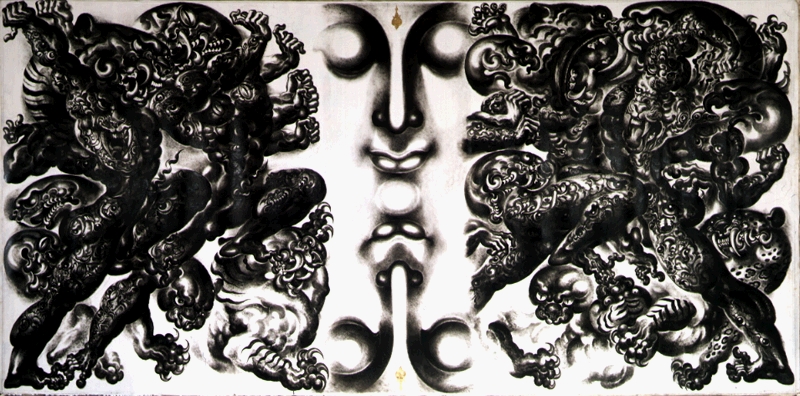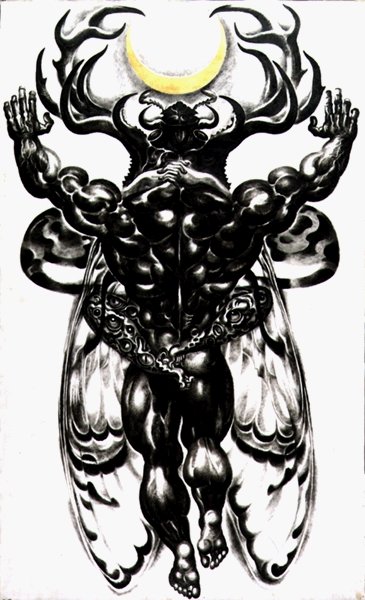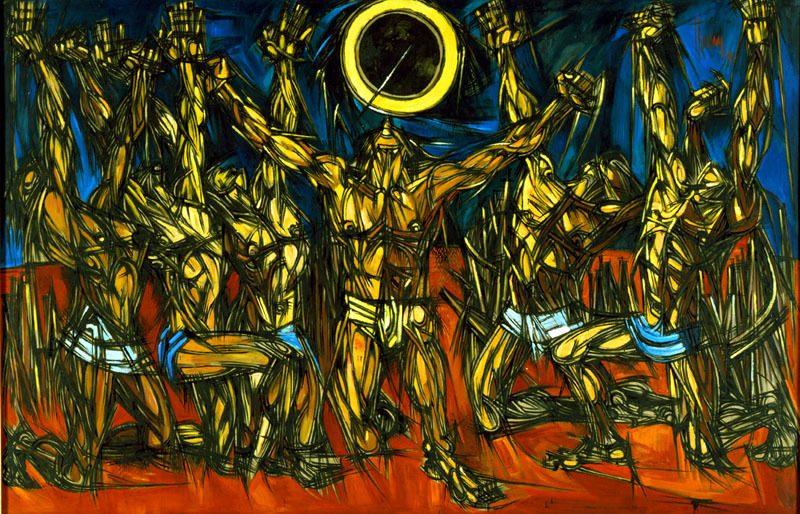5 Famous Artists Who Were Migrants and Other Stories
As long as there have been artists, there have been migrant artists. Like anyone else, they’ve left their homeland and traveled abroad for many...
Catriona Miller 18 December 2024
10 October 2024 min Read

Duchanee gained popularity not just through his provocative (and beautiful) depictions of Buddhism, but also because of his flamboyant personality. At the age of 60, he received the Fukuoka Asian Arts Prize and was then selected as the national artist of Thailand. He even once made the Queen of England laugh.
There are many books, thousands of critics, columns, and essays about my work, but none of them penetrate through concepts of my nature or come close to my spiritual essence and can grip the illusory world of my visible expression.
Thawan Duchanee, 1990, note to Fukuoka Asian Art Museum prior to the catalog
The title of this article is a quote from Duchanee’s public lecture at the Fukuoka Asian Art Museum (2001). In accordance with his sentiment, let’s explore three of Duchanee’s painting without too much explanation!

On either side of this large painting, there are monstrous creatures fighting. The detail is remarkable and captivating. There is evidently an interest in grotesque and powerful bodies throughout Duchanee’s work, which is exemplified in this work. The chunky body parts, which recall human limbs, in some way, translate negative human emotions into the beasts.
Duchanee’s work is probably Buddhist art as you’ve never seen it before. At the center of Self is a depiction of Buddha. It also looks quite similar to the artist, and considering the painting’s title, it might be a self-portrait. Duchanee was a Buddhist who did not separate his religion from his art.
My work is my love made visible, I work with all my heart and soul.
2001, Acceptance speech for the Fukuoka Arts and Culture Prize
The majority of people in Thailand, Duchanee included, practice Buddhism. It is an important context for his art, which often depicts his personal perspective on religion. Nonetheless, his art has regularly attracted criticism. At his first solo exhibition in Thailand in 1971, a group of 80 students destroyed his work with metal rulers and box cutters.
The furor is possibly understandable in the context of the Thai Buddhist tradition, which revolves around the three Cs: clean, clear, and calm. Duchanee’s paintings are often violent and provocative. His monochrome style and contradictory abstractions evidently go strikingly against the grain. Because of his themes of madness, violence, and eroticism, his art was regularly interpreted as blasphemous.
On the other hand, Duchanee himself dismissed the criticisms of his work as ignorant. He explained that often the language spoken in temples was Old Pali, meaning 99% of people didn’t understand what was being said. When he first started working in Thailand, people assumed he was a Christian and therefore that his work was an attack on Buddhism. His reputation, however, gradually improved with the consistent advocacy of leading Thai intellectuals like Kukrit Pramoj.
Everything in this world has two sides, good and bad, darkness and brightness, gentleness and strength. So my painting shows the two sides.
2004, Interview for the exhibition Trinity at The Queen’s Gallery, Bangkok, Thailand
Self is an excellent example of how Duchanee’s works often incorporate both serene and violent images. The coexistence of the abominable beasts alongside Buddha could be a metaphor for human imperfection. Overall, despite the fighting monsters, the piece achieves balance through its symmetry. The expression of Buddha could be that of mercy or grief. Do you think the eyes are open or closed?

Duchanee’s paintings regularly depict insanity, degeneration, violence, eroticism, and death. This reflects Buddhist teachings on worldly desires. Future is a succinct demonstration of these themes.
The piece depicts the world after an apocalypse, where insects are the only remaining form of life. Duchanee was of the opinion that the human race will one day destroy itself with nuclear weapons. Next, the new creature, possibly a hybrid with insects, will come into being. However, without the appreciation of Buddhist philosophy, the cycle of destruction will continue. Only then will life reach nirvana and escape the earth.
In this image, Duchanee features his signature muscular hybrids. The fragile and transparent wings, possibly like those of a cicada or butterfly, contrast with the bulging fingers and toes. It’s an erotic and shocking image of degeneration.
Duchanee’s incredible depictions are full of life and movement. The fluidity of their movement perhaps reminds us of the artist’s other works that employ Zen calligraphy. It also demonstrates his illustrative skills. Amazingly, Duchanee never made a detailed plan before painting.
Once the brush touches the paper, the stroke is complete. I never come back to the same place, unlike impressionists who must draw many strokes in one place to create an atmosphere.
2004, interview for the Trinity exhibition
His skill in illustration was kindled at Silpakorn University, Bangkok. Corrado Feroci (Silpa Bhilasri), who was an Italian-born sculptor considered to be the father of modern art in Thailand, taught Duchanee. Feroci once gave him the lowest grade, criticizing his drawings for lacking life.
I need to see fangs, tusks, claws, talons, skins of carnivores because the sense of taste, touch, smell, sight, and sound sharpen my imagination.
2004, interview for the Trinity exhibition
Throughout his career, Duchanee successfully corrected this fault. He would collect animal skulls in order to help him revive the creatures within his paintings. In 1979, Duchanee undertook a commission to paint Germany’s Gottorf Castle; on this three-year trip, he collected countless antlers, which you can still see at his home in Thailand.
I am not a surrealist, I am Thawan Duchanee.
Thawan Duchanee, 2004, interview for the Trinity exhibition
Duchanee studied Western History of Art, and many different artistic styles, at Academie van Beeldende Kunsten (Royal Academy of Visual Arts) in Amsterdam (1964/1966 and 1968/1971). As a first-year student, he was impressed with Western art. He would order extravagant supplies such as chicken skin-textured paper from England, or Velázquez scarlet from Spain. He reached saturation, however, and later reverted to simplicity. Afterward, Duchanee would stress that his inspirations were not limited to Western art, mentioning, for example, the epic of Ramayana, when denying the label of “surrealist.”

Duchanee painted Worship for his graduation exhibition when he was 21 years old. It shows young men praying and looking up at a solar eclipse.
I feel that the eclipse of the Sun is the only phenomenon that makes us insecure in the natural world.
2001, “Message of the Soul,” public lecture at Fukuoka Asian Art Museum.
In a talk at the Fukuoka Asian Art Museum in 2001, Duchanee discussed how an eclipse is a numinous moment. He shared how his mother passed away during a solar eclipse in 1995.
In his early career, Duchanee used colors in his art. At the age of 30, however, he turned to a monochrome palette. This change was influenced by Japanese and Chinese art.
When I was young, I was filled with a lot of love, passion, and pleasure of life. As I got older, my thoughts were getting more matured. I see the world only in black and white.
2001, Message of the Soul, public lecture at the Fukuoka Asian Art Museum
DailyArt Magazine needs your support. Every contribution, however big or small, is very valuable for our future. Thanks to it, we will be able to sustain and grow the Magazine. Thank you for your help!